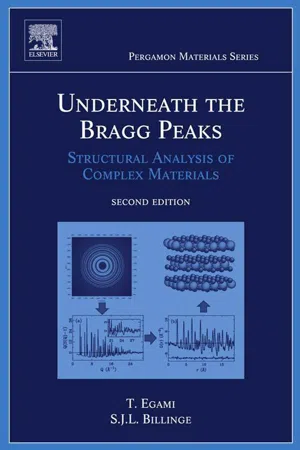Physics
Pair Distribution Function
The Pair Distribution Function (PDF) is a mathematical function that describes the probability of finding two particles separated by a certain distance in a material. It is commonly used in the study of the structure of materials, such as liquids, glasses, and crystals, and can provide information about the arrangement of atoms or molecules in a material.
Written by Perlego with AI-assistance
Related key terms
Related key terms
1 of 4
Related key terms
1 of 3
5 Key excerpts on "Pair Distribution Function"
- eBook - ePub
- Marc Descamps(Author)
- 2016(Publication Date)
- Wiley-VCH(Publisher)
/λ, to limit the effects of cut-off in the Fourier transform. This requires working with short wavelengths less accessible to laboratory instruments, and has long limited the use of the PDF to the field of amorphous materials and liquids. More recently, the PDF analysis took a new development thanks to its usefulness in the study of local structural effects and nanomaterials to the emergence of instruments well suited for PDF measurements at synchrotron and neutron sources and to the development of user-friendly software to process and analyze the data.Depending on the authors and the communities, there are different definitions of the PDF. We will not go into the details here, and the interested reader can refer to the article by Keen [6], where the relationships between different definitions are explained. We will here follow the formalism developed by Egami and Billinge [7].The PDF G(r) yields the probability of finding a pair of atoms separated by a distance r. It can be calculated from a structural model describing the distribution of atoms in a sample according to the formula:10.1where the summation is throughout the atoms contained in the structural model, separated by the distance rij . bi is the scattering power of atom i (its Fermi length for neutrons, its form factor for X-rays or electrons), ⟨b⟩ is the average scattering power of the sample, and ρ0 is the numerical density of compound, that is, the number of atoms per unit volume. This function will have peaks for values of r corresponding to interatomic distance in the model, the intensity of these peaks being proportional to the product of the scattering factors of the atoms forming the pair. All the contributions of all pairs of atoms add up in the PDF. However, it is possible to calculate partial PDFs by taking into account selected atoms only (Figure 10.1 ). It is worth noting that Eq. (10.1 ) is strictly valid only for neutron scattering for which the Fermi length b is independent of Q in reciprocal space so that ⟨b⟩ can be calculated unambiguously. For X-rays and electrons, the form factors are Q-dependent and the shape of F(Q) depends on the element considered so that Eq. (10.1 - José A. Rodriguez, Jonathan C. Hanson, Peter J. Chupas(Authors)
- 2013(Publication Date)
- Wiley(Publisher)
5 Pair Distribution Function Analysis of High-Energy X-ray Scattering Data Karena W. Chapman and Peter J. Chupas5.1 Introduction
Pair Distribution Function (PDF ) analysis is an emerging structure characterization tool with the potential to provide valuable new insights into a broad range of problems in heterogeneous catalysis. The method yields atomic scale structural information with crystallographic resolution, without the need for crystalline order implicit in conventional Bragg diffraction analysis. Accordingly, it can be used to study the nanoscale and/or defect-rich materials systems often involved in heterogeneous catalysis.While the methodology itself is not new [1–3], the application of PDF methods to address problems in catalysis, and complex materials in general, is less developed than many other techniques, due to previously limited access to high-quality data. Since the early 2000s, advances in experimental approach, instrumentation, and detector technologies have increased access to PDF data, providing improved data quality in substantially reduced measurement times [4, 5]. Accordingly, it has now become possible to conduct quantitative PDF measurements with appropriate sensitivity and on timescales relevant to the structural changes in heterogeneous catalysts.The use of PDF methods to understand and optimize heterogeneous catalysts is rapidly expanding and the potential of this approach is only now being fully explored [6–21]. Studies are being extended beyond determining the static structure of catalytic materials, and any changes that may occur following ex-situ/offline treatment, to in-situ studies under nonambient conditions relevant to catalytic synthesis, operations, or deactivation. This includes variable temperature, pressure, and reactive chemical environments. Demonstrated in-situ- eBook - ePub
Underneath the Bragg Peaks
Structural Analysis of Complex Materials
- Takeshi Egami, Simon J.L. Billinge(Authors)
- 2012(Publication Date)
- Pergamon(Publisher)
Chapter 3
The Method of Total Scattering and Atomic Pair Distribution Function Analysis
Egami Takeshi Simon J.L. BillingeAbstract
In this chapter the atomic Pair Distribution Function (PDF) is defined. The equations are derived from basic scattering equations. The full range of PDF related equations are laid out and a brief history of the method is presented. A number of extensions to the basic PDF method are presented such as PDFs in higher dimensions and compositionally resolved PDFs. Finally, the theory behind some practical aspects of the method are presented, such as handling and estimating errors and the application of the Nyquist-Shannon sampling theorem to the method.Keywords
atomic Pair Distribution Function (PDF) equations; PDF history; multi-component PDF; compositionally resolved PDF; PDF in high dimensions; anisotropic PDF; error analysis in the PDF; termination effects; Nyquist-Shannon sampling; EXAFS3.1 Total Scattering and the PDF
3.1.1 Introduction
As we discussed in Chapter 2 , in standard crystallographic analysis, the Bragg peaks and diffuse-scattering intensities were treated separately. The structure is determined solely based upon the information provided by the position and intensity of the Bragg peaks, while additional information regarding deviations from the perfect lattice is obtained through the study of diffuse scattering. This approach makes sense when the deviations are small, but when the structure is extensively disordered it fails in practice.In this chapter, we present an alternative approach which treats both the Bragg and the diffuse scattering on an equal basis, the so-called total-scattering technique. Data from throughout reciprocal space, over a wide range of Q - eBook - ePub
Statistics for Process Control Engineers
A Practical Approach
- Myke King(Author)
- 2017(Publication Date)
- Wiley(Publisher)
5 Probability Density FunctionThe probability density function (PDF) is a mathematical function that represents the distribution of a dataset. For example, if we were to throw a pair of unbiased six‐sided dice 36 times, we would expect (on average) the distribution of the total score to be that shown by Figure 5.1 . This shows the frequency distribution. To convert it to a probability distribution we divide each frequency by the total number of throws. For example, a total score of 5 would be expected to occur four times in 36 throws and so has a probability of 4/36 (about 0.111 or 11.1%). Figure 5.2 shows the resulting probability distribution.Expected frequency of total score from two diceFigure 5.1Expected distributionFigure 5.2Throwing dice generates a discrete distribution; in this case the result is restricted to integer values. Probability should not be plotted as continuous line. The probability of a non‐integer result is zero. But we can develop an equation for the line. In this case, if x is the total scored, the probability of scoring x is(5.1)Because x is discrete this function is known as the probability mass function (PMF). If the distribution were continuous we can convert the probability distribution to a probability density function (PDF) by dividing the probability by the range over which it applies.A condition of both functions is that the area they contain must be unity (or 100%) – in other words we are certain to be inside the area. So, in general(5.2)Provided this condition is met then any function can be described as a PDF (or PMF). We will show later that there are many functions that have a practical application. Unfortunately there are a larger number that appear to have been invented as a mathematical exercise and are yet to be shown that they describe any real probability behaviour.While the PMF allows us to estimate the probability of x having a certain value, the PDF does not. It only tells us the probability of x falling within a specified range. The probability of x being between a and b - eBook - ePub
- Duncan W. Bruce, Dermot O'Hare, Richard I. Walton(Authors)
- 2014(Publication Date)
- Wiley(Publisher)
Both sums run over all atoms in the sample. This function, is the radial distribution function of the sample. For a completely random structure, the number of interatomic pairs at a distance is with the average number density of atoms per unit volume. It follows that on average, will increase with. The radial distribution function is related to the pair density function by: 3.22 At large distances the pair density function oscillates around the average number density of the structure, while for very short distances its value is zero. This pair density function is finally related to the PDF by division through the average number density: 3.23 This normalised PDF will obviously oscillate around a value of 1 at larger distances. Finally, the relationship between and the reduced PDF is given by: 3.24 As the experimental function is the Fourier transform of the normalised scattering function elements that contribute much to the scattering amplitude will likewise contribute much to the experimental. In the case of neutron diffraction, this is taken into account by multiplying the histogram by the scattering length of the atoms: 3.25 where and are the individual scattering lengths of atoms and and is the average scattering length of all atoms. In the case of X-ray diffraction, one has to take into account that the atomic form factors vary as a function of. Fortunately, this -dependence does essentially cancel out in the quotient and one can replace the scattering lengths by the ordinal numbers,. Equation 3.25 corresponds to a snapshot in time. In order to obtain a realistic that can be compared to the experimental the thermal vibrations in the sample must be modelled properly. If a large crystal has been modelled, each individual atom can be moved at random according to a distribution function with a width defined by its atomic displacement parameter (ADP). As a result, the interatomic distances will be distributed over a wider range
Index pages curate the most relevant extracts from our library of academic textbooks. They’ve been created using an in-house natural language model (NLM), each adding context and meaning to key research topics.
Explore more topic indexes
Explore more topic indexes
1 of 6
Explore more topic indexes
1 of 4




